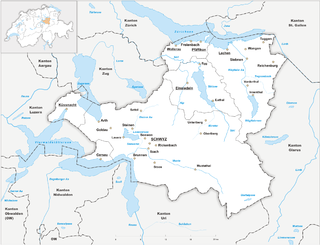
The canton of Schwyz is a canton in central Switzerland between the Alps in the south, Lake Lucerne to the west and Lake Zürich in the north, centred on and named after the town of Schwyz.
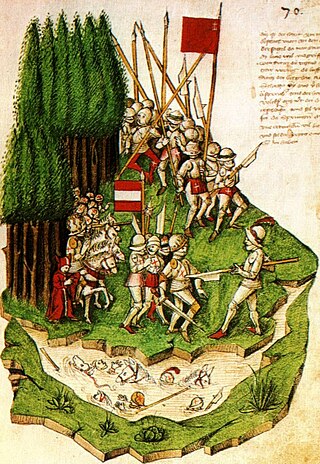
The Battle of Morgarten took place on 15 November 1315, when troops of Schwyz, supported by their allies of Uri and Unterwalden, ambushed an Austrian army under the command of Leopold I, Duke of Austria on the shores of Lake Ägeri, in the territory of Schwyz.

The Federal Charter or Letter of Alliance is one of the earliest constitutional documents of Switzerland. A treaty of alliance from 1291 between the cantons of Uri, Schwyz and Unterwalden, the Charter is one of a series of alliances from which the Old Swiss Confederacy emerged. In the 19th and 20th century, after the establishment of the Swiss federal state, the Charter became the central founding document of Switzerland in the popular imagination.

Obwalden or Obwald is one of the 26 cantons forming the Swiss Confederation. It is composed of seven municipalities and the seat of the government and parliament is in Sarnen. It is traditionally considered a "half-canton", the other half being Nidwalden.
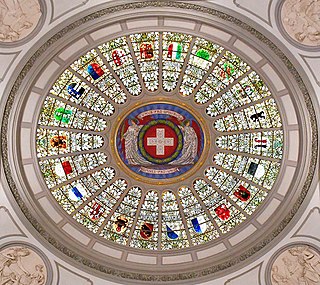
Each of the 26 modern cantons of Switzerland has an official flag and a coat of arms. The history of development of these designs spans the 13th to the 20th centuries.

The Sonderbund War of November 1847 was a civil war in Switzerland, then still a relatively loose confederacy of cantons. It ensued after seven Catholic cantons formed the Sonderbund in 1845 to protect their interests against a centralization of power. The war concluded with the defeat of the Sonderbund. It resulted in the emergence of Switzerland as a federal state, concluding the period of political "restoration and regeneration" in Switzerland.

The Old Swiss Confederacy began as a late medieval alliance between the communities of the valleys in the Central Alps, at the time part of the Holy Roman Empire, to facilitate the management of common interests such as free trade and to ensure the peace along the important trade routes through the mountains. The Hohenstaufen emperors had granted these valleys reichsfrei status in the early 13th century. As reichsfrei regions, the cantons of Uri, Schwyz, and Unterwalden were under the direct authority of the emperor without any intermediate liege lords and thus were largely autonomous.
The wars of Kappel (Kappelerkriege) is a collective term for two armed conflicts fought near Kappel am Albis between the Catholic and the Protestant cantons of the Old Swiss Confederacy during the Reformation in Switzerland.
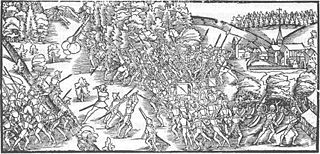
The Second War of Kappel was an armed conflict in 1531 between the Catholic and the Protestant cantons of the Old Swiss Confederacy during the Reformation in Switzerland.
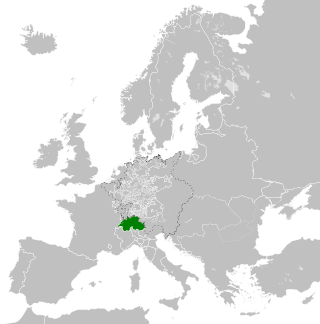
The Old Swiss Confederacy, also known as Switzerland or the Swiss Confederacy, was a loose confederation of independent small states, initially within the Holy Roman Empire. It is the precursor of the modern state of Switzerland.

The Battle of Crevola was fought in the spring of 1487, between a marauding Swiss army from the Valais and Lucerne and troops from the Duchy of Milan, for the supremacy of the Val d'Ossola (Eschental).
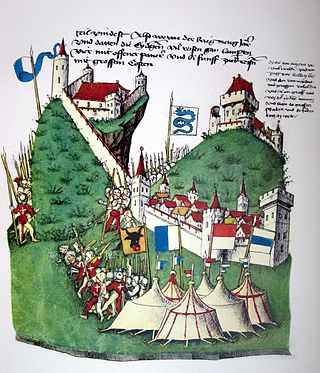
The Battle of Arbedo was fought on 30 June 1422 between the Duchy of Milan and the Swiss Confederation, and ended with a Milanese victory.
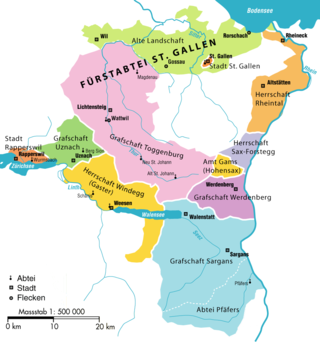
The County of Sargans was a state of the Holy Roman Empire. From 1458 until the French Revolutionary War in 1798, Sargans became a condominium of the Old Swiss Confederacy, administered jointly by the cantons of Uri, Schwyz, Unterwalden, Lucerne, Zürich, Glarus and Zug.

The French invasion of Switzerland occurred from January to May 1798 as part of the French Revolutionary Wars. The independent Old Swiss Confederacy collapsed from the invasion and simultaneous internal revolts called the "Helvetic Revolution". The Swiss ancien régime institutions were abolished and replaced by the centralised Helvetic Republic, one of the sister republics of the French First Republic.

The Raron affair was a 15th-century rebellion in the Valais against the power of a local noble family, the Raron family. The rebellion brought several cantons of the Swiss Confederation into conflict with each other and threatened a civil war in the Confederation. While Bern was initially successful, they were eventually forced to surrender most of their gains.
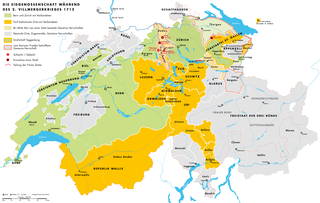
The Toggenburg War, also known as the Second War of Villmergen or the Swiss Civil War of 1712, was a Swiss civil war during the Old Swiss Confederacy from 12 April to 11 August 1712. The Catholic "inner cantons" and the Imperial Abbey of Saint Gall fought the Protestant cantons of Bern and Zürich as well as the abbatial subjects of Toggenburg. The conflict was a religious war, a war for hegemony in the Confederacy and an uprising of subjects. The war ended in a Protestant victory and upset the balance of political power within the Confederacy.
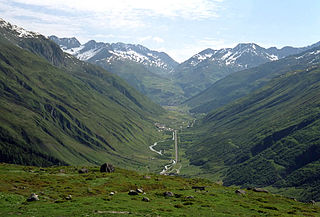
Uri is a Swiss Talschaft and canton in the upper Reuss valley.

The First Battle of Ulrichen in 1211 was a decisive defeat of Bernese troops under Duke Berthold V of Zähringen by the army of the Canton of Valais under the Bishop of Sion Landrich von Mont. The battle took place near Ulrichen which is now part of Obergoms. Many details about the battle are uncertain or questioned by historians.
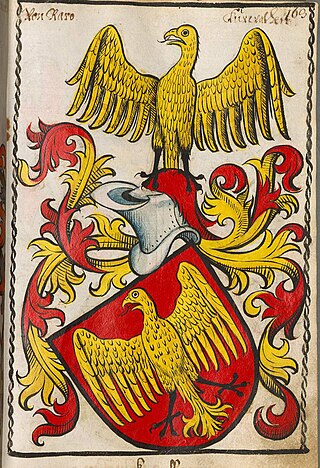
Von Raron was an influential noble family in the Valais in the late medieval period.

Swiss Associates, also known as Associated Places,Zugewandte Orte, or Pays Alliés, were associate states of the Old Swiss Confederacy, with some form of alliance agreement with either the entire Confederation or individual cantons.





















